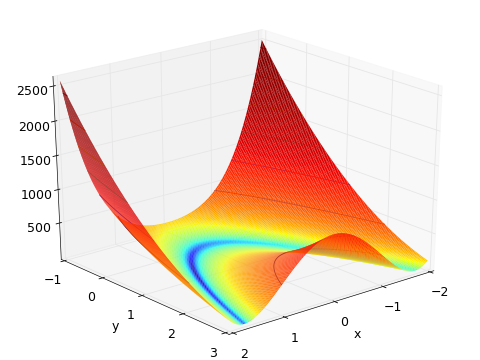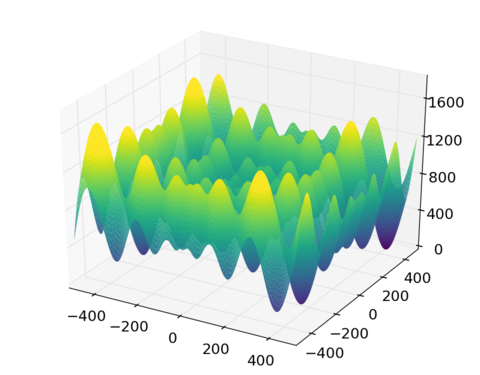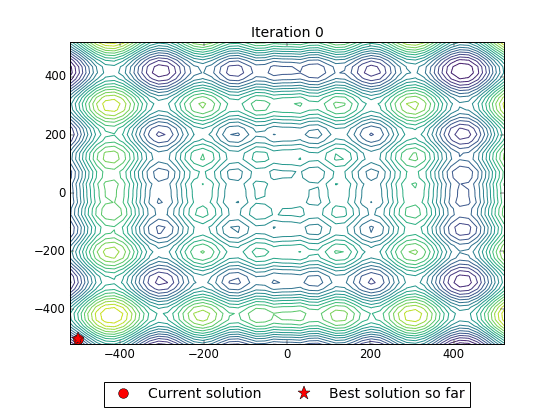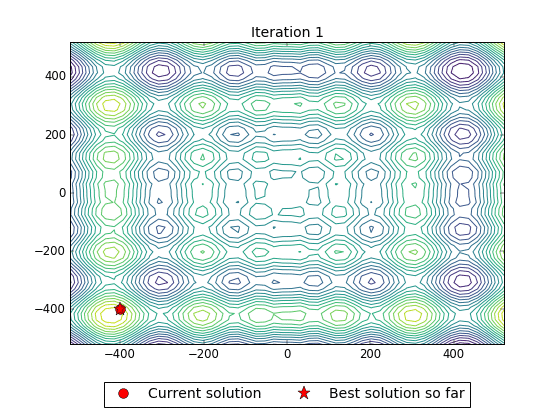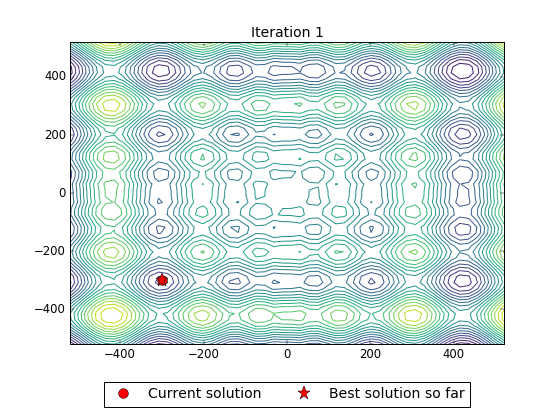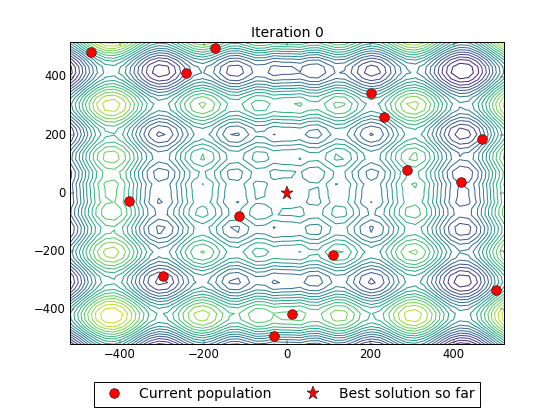This project is a suite of global optimization algorithms for C++ inspired by SciPy's global optimization package. Currently supported functions are:
- pallas::Basinhopping
- pallas::Brute
- pallas::DifferentialEvolution
- pallas::SimulatedAnnealing
For more information on the options for each algorithm please see the documentation at: http://latture.github.io/pallas-solver
To use this library first install glog and CMake. Pallas is based off of the Google Ceres project which has extensive use of glog for logging and debugging features, and this functionality is carried over into Pallas. Follow the instructions to install Ceres at ceres-solver.org/building.html. Once CMake, Ceres, and glog are built and installed use the following steps to build Pallas:
- Navigate to the pallas root directory.
- On the same level as the
README.md, create a folder namedbuild. - In the terminal, navigate to the newly created
buildfolder. - Execute the following command:
cmake .. -DCMAKE_PREFIX_PATH=/path/to/CeresConfig.cmake, where/path/to/CeresConfig.cmakedenotes the folder where the fileCeresConfig.cmakeis located Currently on Linux, Ceres by default will place this file at/usr/local/share/Ceres, though this may change in the future and may be different on your machine. - From within the same build directory execute
makein the terminal. This should build Pallas. The folderbuild/libwill hold the library
The Rosenbrock function (shown below) is a commonly used benchmarking function for optimization algorithms. The global minimum is in the middle of a narrow valley at f(x, y) = 0 when x = y = 1. Finding the valley is fairly easy; however, finding the global minimum is quite a bit harder...
#include "glog/logging.h"
// Each solver is defined in its own header file.
// include the solver you wish you use:
#include "pallas/basinhopping.h"
// define a problem you wish to solve by inheriting
// from the pallas::GradientCostFunction interface
// and implementing the Evaluate and NumParameters methods.
class Rosenbrock : public pallas::GradientCostFunction {
public:
virtual ~Rosenbrock() {}
virtual bool Evaluate(const double* parameters,
double* cost,
double* gradient) const {
const double x = parameters[0];
const double y = parameters[1];
cost[0] = (1.0 - x) * (1.0 - x) + 100.0 * (y - x * x) * (y - x * x);
if (gradient != NULL) {
gradient[0] = -2.0 * (1.0 - x) - 200.0 * (y - x * x) * 2.0 * x;
gradient[1] = 200.0 * (y - x * x);
}
return true;
}
virtual int NumParameters() const { return 2; }
};
int main(int argc, char** argv) {
google::InitGoogleLogging(argv[0]);
// define the starting point for the optimization
double parameters[2] = {-1.2, 0.0};
// set up global optimizer options only initialization
// is need to accept the default options
pallas::Basinhopping::Options options;
// initialize a summary object to hold the
// optimization details
pallas::Basinhopping::Summary summary;
// create a problem from your cost function
pallas::GradientProblem problem(new Rosenbrock());
// solve the problem and store the optimal position
// in parameters and the optimization details in
// the summary
pallas::Solve(options, problem, parameters, &summary);
std::cout << summary.FullReport() << std::endl;
std::cout << "Global minimum found at:" << std::endl;
std::cout << "\tx: " << parameters[0] << "\ty: " << parameters[1] << std::endl;
return 0;
}After compiling and running, the console should display the following:
Solver Summary
Parameters 2
Line search direction LBFGS
Cost:
Initial 2.122000e+02
Final 3.300841e-27
Change 2.122000e+02
Minimizer iterations 21
Time (in seconds):
Cost evaluation 0.0000
Local minimization 0.0015
Step function 0.0000
Total 0.0015
Termination: CONVERGENCE (Maximum number of stagnant iterations reached.)
Global minimum found at:
x: 1 y: 1This example (among others) can be found in the examples folder.
To illustrate each algorithm we'll use Schwefel's function (shown above) defined as:
class Schwefel : public pallas::GradientCostFunction {
public:
virtual ~Schwefel() {}
virtual bool Evaluate(const double* parameters,
double* cost,
double* gradient) const {
double c = 0.0;
for (auto i = 0; i < NumParameters(); ++i)
c -= parameters[i] * std::sin(std::sqrt(abs(parameters[i])));
cost[0] = 418.9829 * NumParameters() + c;
if (gradient != NULL) {
double g = 0.0;
for (int i = 0; i < NumParameters(); ++i)
gradient[i] = parameters[i] * cos(sqrt(abs(parameters[i]))) / (2.0 * pow(abs(parameters[i]), 1.5));
}
return true;
}
virtual int NumParameters() const { return 2; }
};Brute force is a simple N-dimensional, grid-based search through the parameter space. To use, specify the objective function and the parameter ranges via:
std::vector<pallas::Brute::ParameterRange> ranges = {pallas::Brute::ParameterRange(-500.0, 500.0, 50),
pallas::Brute::ParameterRange(-500.0, 500.0, 50)}This will divide the ith parameter into 50 equally spaced search points. The objective will be evaluated at each parameter combination. While not an efficient optimization strategy, brute force is often used as a coarse-grained search of the parameter space in order to identify areas of interest that can be further explored with other, more efficient, algorithms.
Simulated annealing is a global optimization algorithm that doesn't need derivative information. Randomized steps are generated about the current solution vector forming a candidate solution. Then the current solution chooses whether or not accept (and thus to move to) the candidate solution based on the cost associated with the candidate solution. If it is lower than the current cost, the candidate solution is accepted. If it is higher, the candidate isn't simply thrown out. The current solution moves to a worse candidate solution with a given probability in hopes that accepting worse solutions will allow the algorithm to surmount local optima and find the global minimum. The likelihood of accepting a worse candidate solution is controlled by the system temperature: higher temperatures mean the worse candidate is more likely to be accepted. As optimization progresses, the temperature is slowly decreased (i.e. the system simulates an annealing process) and the likelihood of accepting worse candidate solutions is decreased later in the optimization. The method of cooling the system is controlled via a CoolingSchedule. Pallas provides three schedules: FastCooling, CauchyCooling and BoltzmannCooling. For information on how these control temperature see pallas/cooling_schedule.h.
Basinhopping is very similar to simulated annealing with one additional step: after each randomized step the candidate solution is fed into a local optimizer in order to move the candidate solution to the bottom of the current basin. This locally optimized candidate is then compared to the current solution in order to decide whether to accept the candidate. This allows the optimizer to traverse the energy landscape in a reduced subset of space where only local optima are present. In effect, much fewer total iterations are needed compared to simulated annealing, but this comes a higher cost per iteration because instead of simply taking a randomized step, a local optimization must be performed during each iteration (Notice the iteration count compared to simulated annealing). In general, when using Basinhopping you will need at least as many iterations as there are local optima.
Differential evolution is different than the previous algorithms. Instead of maintaining a single current solution, it evolves a population of candidate solutions through a series of generations in order to find the global optimum. Children of the current population are created using crossover and mutation strategies. Crossover selects 1 or more individuals for reproduction then generates a candidate solution vector that undergoes mutation (with some probability) and is placed in the next generation's population. Crossover and mutation strategies are selected using the DifferentialEvolution::Options struct.
Pallas global optimization algorithms take as inputs an Options struct class specific to each optimizer, GradientProblem which encapsulates the objective function to optimize, a const double* pointing to the initial starting point for optimization (except for Brute which takes a range of parameters), and a summary in which details of the optimization are stored. The Options struct is a subclass specific to each optimizer exposing the options that can be changed in order to customize the optimization procedure. If Basinhopping is being used as the global optimizer, creating an instance of the default options is as simple as:
pallas::Basinhopping::Options options;The default options can be changed by accessing member variables:
options.maxiterations = 1000;If the global optimizer employs a local minimizer, the options for the local minimizer are accessed through the options.local_minimizer_options minimizer variable. options.local_minimizer_options is itself a struct containing the parameters to augment the functionality of the local minimization step(s). The local minimization options are from the ceres::GradientProblemSolver renamed to pallas::GradientLocalMinimizer to avoid confusion between the global and local solvers. If DifferentialEvolution is being used as the global optimizer, the options struct requires that upper and lower bounds be set for the current problem. Note, however, that if the final output is polished (options.polish = true) the local optimization will not respect the bounds of the global optimization due to the restriction of the Ceres local optimization algorithms to purely unbounded problems. Both the SimulatedAnnealing and Basinhopping algorithms use the StepFunction class to generate randomized candidate solutions. A pallas::scoped_ptr to a DefaultStepFunction is created by default. This is not going to give optimal results for your problem. If either of these algorithms are being used a class should inherit from StepFunction and implement the Step method which takes as inputs a pointer to the current solution and the number of parameters, then modifies the current solution in place. If a StepFunction is used by the global optimizer, then the options struct has a helper method set_step_function that swaps the pointer to the default step function with the user defined functor. The following shows how to create a step functor and replace it as the step function pointer in the options struct:
// inherit from StepFunction and implement Step method
class CustomStepFunction : public pallas::StepFunction {
public:
CustomStepFunction(double step_size)
: random_number_(new pallas::internal::RandomNumberGenerator<double>(-step_size, step_size)) {
};
void Step(doublex, unsigned int num_parameters) {
// implementation to modify x in place
};
private:
pallas::scoped_ptr<pallas::internal::RandomNumberGenerator<double>> random_number_;
};
// create the options for the solver
pallas::Basinhopping::Options options;
// instantiate scoped pointer to StepFunction
pallas::scoped_ptr< CustomStepFunction > step(new CustomStepFunction(1.0));
// use convenience method to replace default step function
options.set_step_function(step);Subclassing pallas::GradientCostFunction
and implementing the Evaluate and NumParameters methods defines your objective function.
Create a GradientProblem using:
pallas::GradientProblem problem(new YourObjectiveFuntion());The gradient problem is what is then passed to the solver. The parameters for the global optimization represents an initial guess required for the Basinhopping and SimulatedAnnealing algorithms. It should be a double* and contain the same number of values as the NumParameters method returns. Each global optimizer contains a Summary class used to store the results of the global optimization. The summary is created in the same manner as the options struct, i.e.:
pallas::Basinhopping::Summary summary;This is then passed as the final parameter to the solver. There are 2 methods optimize a cost function. An instance of the solver can be created then optimized using the global_optimizer.Solve method. There is also a pallas::Solve function added for convenience. It is overloaded to create a global optimizer instance and run the optimization based on the parameters passed to the function. To summarize, the two method of optimization are given by:
// create an instance of a global optimizer
pallas::Basinhopping bh;
bh.Solve(options, problem, parameters, &summary);
// bypass the creation of the optimizer
pallas::Solve(options, problem, parameters, &summary)If you want more information take a look at the examples folder. There's a full example using each algorithm. For even more information and a list of the available options for each algorithm, see the reference documentation at: http://latture.github.io/pallas-solver
- Ryan Latture
This library uses the local minimization algorithms from Google's Ceres solver. Implementations of the global optimization algorithms are based on Scipy's optimize package. Because of the similarities between the Pallas algorithms and scipy.optimize, much of the documentation was adapted from their source.
